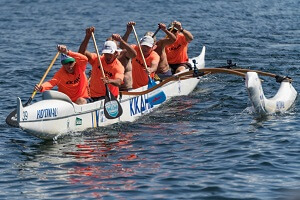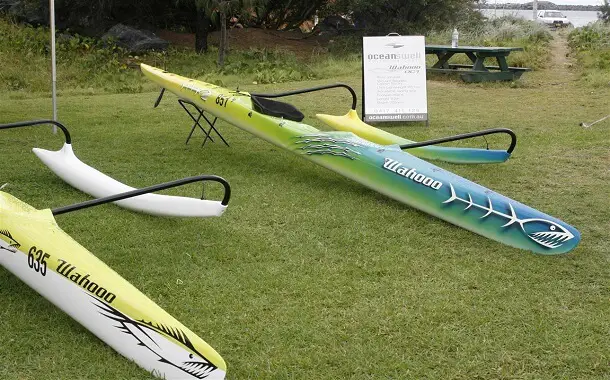How Much Does an Outrigger Canoe Cost?
Last Updated on January 31, 2024
Written by CPA Alec Pow | Content Reviewed by ![]() CFA Alexander Popinker
CFA Alexander Popinker
Outrigger canoes are popular watercraft known for their stability and speed. But before buying one, an important question to ask is – how much does an outrigger canoe cost?
In this comprehensive guide, we’ll break down all the factors that impact outrigger canoe pricing and provide detailed price ranges so you can set a realistic budget for this exciting investment.
When considering the cost of an outrigger canoe, it’s essential to take various factors into account, such as the materials used, whether you’re purchasing new or used, the brand, size, and potential customs fees.
Additionally, it’s crucial to budget for storage, ongoing maintenance, and any necessary accessories. To make an informed decision, conduct thorough research on different brands and consider trying out demo models.
How Much Does an Outrigger Canoe Cost?
Outrigger canoes range widely in cost from $1,500 for basic recreational models to over $15,000 for customized, high-performance racing canoes.
The final price depends on many variables – the materials, brand, whether it’s new or used, additional accessories, custom designs, size, and capacity. While not a cheap sport, investing in an outrigger canoe opens up limitless adventures and fun on the water.
Based on the many influencing factors covered, here is an overview of common price ranges grouped into entry-level, mid-range, and high-performance categories:
Entry-Level Outriggers cost between $1,500 and $3,500
Focused on affordability and accessibility, entry-level outriggers appeal to beginners or those on a tight budget. Expect basic recreational canoes 12-18 feet long made of fiberglass or wood from Hawaiian manufacturers like Bradley. Seats 1-3 people. Best for casual cruising and introduction to this exciting sport.
- Single or double hull
- 12–16-foot length
- Fiberglass or wood construction
- 1–3-person capacity
- No frills design, entry-level components
Mid-Range Outriggers cost between $3,500 and $7,000
Offering better performance, quality, and versatility, mid-range models by trusted brands will cost more but deliver excellent value. Ideal for both recreational and competitive paddling.
- Fiberglass or wood hulls
- 18–25-foot lengths
- Sprint and distance racing designs
- 4–6-person capacity
- Durable construction from top brands
High-End and Custom Outriggers cost between $8,000 and $15,000+
On the top end, experienced paddlers invest in lightweight and meticulously crafted outriggers purely for competitive racing performance. Expect stunning Hawaiian designs using carbon fiber and similar advanced materials. The sky’s the limit for full customization.
- Carbon fiber/Kevlar construction
- Unlimited customization
- Ultra-light, fast racing hulls
- Hawaiian racing designs and quality
- 8–10-person capacity for teams
Keep in mind, used outriggers can offer significant savings of 40-60% off these new prices if purchased carefully. For example, a used mid-range outrigger may only cost $3,000 rather than $6,000 new.
According to the Hana Hou Paddlesports website, they have for sale Kai Wa’a Draco OC1 for $4,600, or Puakea Designs Volare OC1 for $4,750, among many others.
At Paddle Dynamics you can find the following:
- Ozone Ballare 2 Person Outrigger Canoe: $5,350.00
- Outrigger Zone Draco Pro Outrigger Canoe: $5,350.00
- Outrigger Zone Draco Outrigger Canoe: $4,750.00
- Ozone Ares OC1 Canoe: $4,750.00.
History and Evolution of the Outrigger Canoe
Outrigger canoes originated over 3,000 years ago in the Pacific Islands. Ancient Polynesians first developed these remarkably stable and swift canoes for efficient fishing, transportation, and even war canoes.
The defining feature of the outrigger canoe is the lateral support float connected parallel to the main hull, which prevents capsizing in the open ocean.
The first outrigger canoes were carved from whole logs and featured symmetrical hulls. But over thousands of years, Polynesians refined the design into the faster, more versatile outriggers we know today.
You might also like our articles about the cost of a canoe, kayak, or airboat.
Modern outrigger construction utilizes lightweight materials like fiberglass, carbon fiber, and wood laminates. The hull evolved into an asymmetrical shape with curves for speed.
Today, outrigger canoes are popular among recreational and competitive paddlers worldwide, especially in Hawaii. Hawaiian outrigger canoe clubs perpetuate the heritage of this ancestral Pacific watercraft.
Both single and double-hull outrigger canoes are raced in high-intensity sprint regattas and long-distance events. Outrigger competitions test teamwork, endurance, and paddling skill.
The Different Types of Outrigger Canoes
 There are two main configurations of the outrigger canoe design:
There are two main configurations of the outrigger canoe design:
- Single Hull Outrigger – This features one main V-shaped canoe hull paired with a parallel outrigger pontoon for stabilization. Single hull outriggers seat 1-3 people depending on length. They’re ideal for recreational paddling, exercise, and sprint racing events.
- Double Hull Outrigger – Also called a catamaran hull, this style has two parallel canoe hulls connected by horizontal beams called akas. The outrigger float parallels the two hulls. Double hull outriggers seat 4-9 people depending on length. This versatile design is perfect for long-distance paddling and endurance racing.
Within these two types, outrigger canoes come in a range of lengths from 12 feet long for solo racers to up to 45 feet long for 9-person vessels. In general, shorter outrigger canoes are quicker and more agile while longer canoes can cover more miles efficiently.
Many clubs own a variety of boat sizes for different practices and races.
Factors that Determine Outrigger Canoe Costs
Several variables greatly impact the overall cost of an outrigger canoe. Evaluating these differences helps explain the wide price range.
Hull Materials and Construction
The materials used to construct the outrigger hull play a major role in price. Each option differs in durability, maintenance needs, weight, and performance.
- Fiberglass – The most affordable and commonly used material. Durable and relatively low maintenance. Outrigger canoes made with fiberglass cost approximately $1,500-$5,000. Heavier than other materials.
- Wood – The traditional material with beautiful aesthetic appeal. However, wood requires more frequent care and maintenance. Entry-level wood outrigger canoes cost $2,000-$5,000 depending on craftsmanship.
- Carbon Fiber – This ultra-lightweight woven graphite material creates professional racing hulls costing upwards of $5,000 or more. Very expensive but maximizes speed.
- Kevlar – Similar properties to carbon fiber but slightly heavier. Outriggers made of Kevlar are over $6,000+. Another pricey but high-tech material.
- Wood Strip/Epoxy Composite – This method creates gorgeous handmade, custom wood canoes layered for strength. Expect costs of $8,000+ for premium materials and skilled craftsmanship.
Brand and Quality
The brand and resulting build quality make a big difference in the canoe’s price:
- Entry-Level Brands – Basic recreational fiberglass or wood hulls cost approximately $1,500-$2,500 from smaller manufacturers. Best for beginners and casual paddling.
- Mid-range Brands – Well-known companies like Bradley and C4 Waterman construct higher performance outriggers for $3,000-$7,000 using quality materials and craftsmanship.
- High-End Custom – Custom performance designs or models from top Hawaiian brands such as Hawaiian and Kamanu range from $10,000 to $15,000+.
The premium brands invest in design, materials, and construction that increase speed, durability, and resale value. Yet entry-level brands allow beginners to get started at a more affordable cost.
New vs Used Outrigger Canoes
Buying a used outrigger canoe is an excellent way to save substantial money. Depending on the condition, used outriggers can sell for 40-60% less than the retail price of new models. However, carefully inspect any used canoe for repairs, damage, or material breakdown before purchasing.
New outrigger canoes offer full warranty coverage, the ability to customize, and assurance of the canoe’s full lifespan ahead. But the higher cost must be accounted for.
Size and Capacity
The intended use and number of paddlers dictates the size of outrigger needed:
- Single Person Canoe – Very narrow, designed for training, racing, or skilled paddlers. Solo racing hulls are extremely quick for competitive events.
- Two or Three Person Canoe – Wider beams provide stability for 2-3 paddlers plus equipment and gear. Ideal recreational size for pairs or small groups.
- Six to Ten Person Canoes – The most versatile size for clubs and race teams. However, the longer hull and greater capacity increases costs.
Consider your needs, but remember increased size does equal greater price. Optimal for clubs is owning a variety of outrigger sizes for different practices and number of riders.
Additional Outrigger Canoe Cost Considerations
The purchase price is just the starting point. Be sure to factor in operating costs and additional investments like:
Necessary Accessories and Gear
An outrigger really comes alive when rigged out with must-have accessories:
- Paddles – Well-made paddles designed for outrigger technique run $150-$300 each.
- Seats and rigging – Comfortable seats with fastening rigging $300+.
- Life jackets – Essential for safety, estimate $100+ per person.
- Racks – Secure racks for transporting by car $300+.
Maintenance and Storage
Proper maintenance and storage also require budgeting:
- Annual maintenance – $200+ for materials and time.
- Storage – Rental space if no room to store on property.
- Transportation – Gas and vehicle wear to transport the canoe.
Insurance
- Outrigger canoe insurance protects against theft, damage from $300-$500 annually.
Outrigger Canoe Buying Tips
Follow this advice for finding the right outrigger canoe at the best price:
- Buy used to save substantially if on a tight budget. Inspect carefully.
- Demo models when buying new to choose the optimal size and hull design.
- Consider joining a club – Shares costs of equipment and storage.
- Calculate total ownership costs – Storage, insurance, maintenance.
- Research brands for quality and resale value.
- Allow for accessory costs – Paddles, lifejackets, etc.
Final Words
While buying an outrigger canoe is a big investment, the lifetime of adventures on the water makes it worthwhile. Realistically budget $1,500 to $15,000+ based on your needs. Consider a club to lower costs.
Demo different canoes to pick your ideal model before purchasing. Investing in an outrigger opens up fast, stable, exciting paddling experiences.
Frequently Asked Questions
Why only one outrigger?
The single outrigger design provides stabilization on the open ocean while minimizing weight and drag. Having just one outrigger float on one side is optimal for speed and efficiency.
The outrigger gives the canoe lateral stability to prevent capsizing, while the single hull reduces surface area in the water allowing the canoe to glide fast with less resistance.
How long should my outrigger canoe paddle be?
A properly sized paddle improves paddling performance and comfort. As a general rule, when standing an outrigger paddle on the ground, the top of the grip should reach between your chin and nose in height.
For average height adults, optimal paddle lengths are between 6.5-7.5 feet long. Taller paddlers may need 7–8-foot paddles. It’s also ideal to use feathered paddles with offset blades to reduce wind resistance.
How many people fit in an outrigger canoe?
Outrigger canoes come in solo, two person, and six person sizes. But high-performance Hawaiian six-person outriggers typically seat six paddlers plus a steersperson, so seven total.
Narrower hulls are faster while wider hulls are more stable. For recreational paddling, a six-person outrigger is a versatile size for small groups and families. Racing canoes often seat six paddlers or two pairs of two.


Leave a Reply
Want to join the discussion?Feel free to contribute!